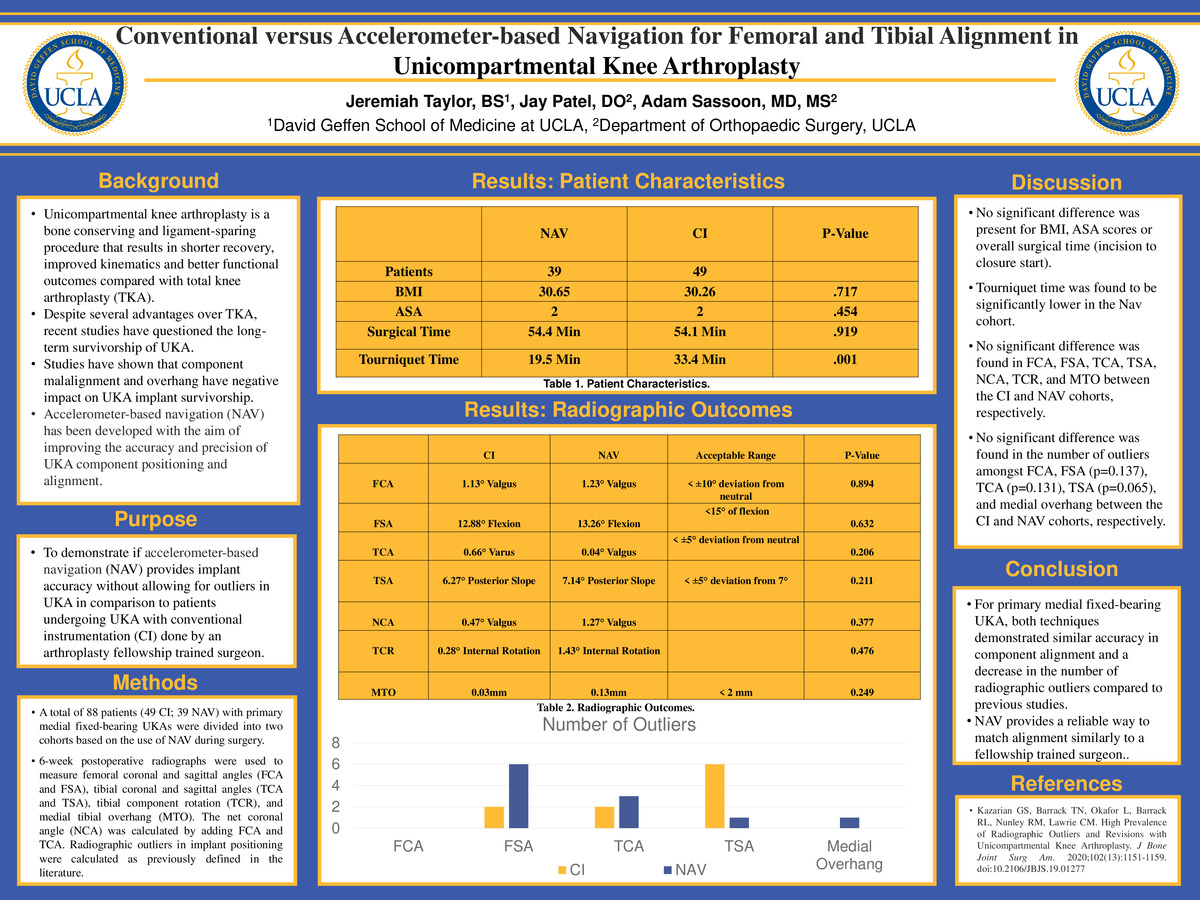-
Author
Jeremiah Taylor -
PI
Adam Sassoon MD, MS
-
Co-Author
Jay Patel DO,
-
Title
Conventional versus Accelerometer-based Navigation for Femoral and Tibial Alignment in Unicompartmental Knee Arthroplasty
-
Program
STTP
-
Other Program (if not listed above)
-
Abstract
Introduction
Previous studies have demonstrated that component malalignment and tibial overhang negatively impact unicompartmental knee arthroplasty (UKA) survivorship.
The purpose of this study is to demonstrate if accelerometer-based navigation (NAV) provides implant accuracy without allowing for outliers in UKA in comparison to patients undergoing UKA with conventional instrumentation (CI) done by an arthroplasty fellowship trained surgeon.
Methods
Prospectively collected data was reviewed using an institutional database. All patients with primary medial fixed-bearing UKAs were divided into two cohorts based on the use of NAV during surgery. 6-week postoperative radiographs were used to measure femoral coronal and sagittal angles (FCA and FSA), tibial coronal and sagittal angles (TCA and TSA), tibial component rotation, and medial tibial overhang. The net coronal angle (NCA) was calculated by adding FCA and TCA. Radiographic outliers in implant positioning were calculated as previously defined in the literature.1
Results
A total of 88 patients were analyzed (49 CI patients; 39 NAV patients). Using two-sample t-tests, no significant difference was found in FCA (1.13° valgus, 1.23° valgus; p=0.894), FSA (12.88° flexion, 13.26° flexion; p=0.632), TCA (0.66° varus, 0.04° valgus; p=0.206), TSA (6.27° posterior slope, 7.14° posterior slope; p=0.211), NCA (0.47° valgus, 1.27° valgus; p=0.377), tibial component rotation (0.28° internal rotation, 1.43° internal rotation; p=0.476), and medial tibial overhang (0.03mm, 0.13mm; p=0.249) between the CI and NAV cohorts, respectively. Using chi-squared tests, no significant difference was found in the number of outliers amongst FCA (0, 0), FSA (2, 6; p=0.137), TCA (2, 3; p=0.131), TSA (6,1; p=0.065), medial overhang (0,1) between the CI and NAV cohorts, respectively.
Conclusion
For primary medial fixed-bearing UKA, both techniques demonstrated similar accuracy in component alignment and a decrease in the number of radiographic outliers compared to previous studies. NAV provides a reliable way to match alignment similarly to a fellowship trained surgeon.
References
1. Kazarian GS, Barrack TN, Okafor L, Barrack RL, Nunley RM, Lawrie CM. High prevalence of radiographic outliers and revisions with unicompartmental knee arthroplasty. J Bone Joint Surg Am. 2020;102(13):1151-1159.
-
PDF
-
Zoom

